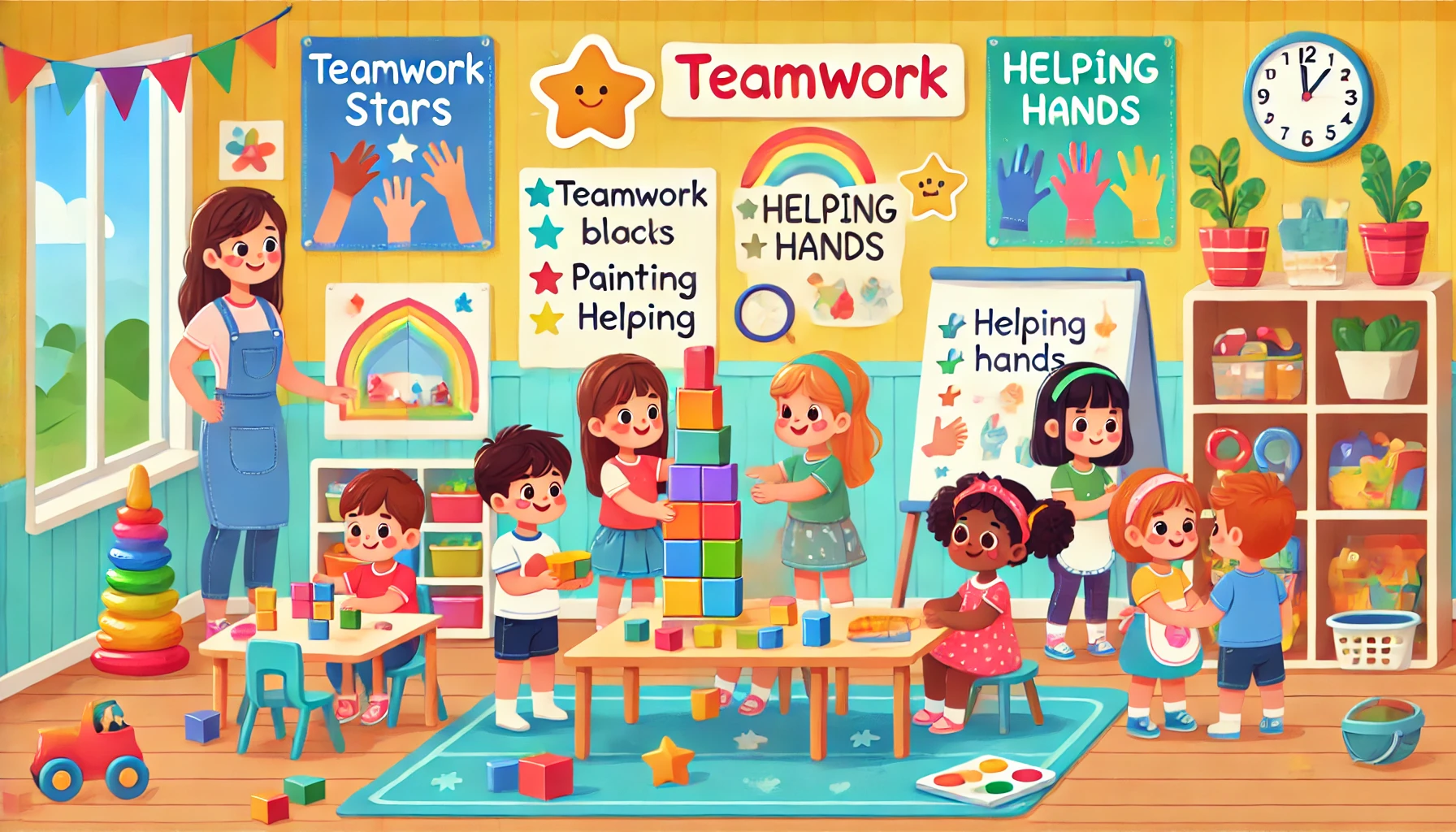Teamwork and collaboration are key social-emotional skills that help young children learn to work with others, share, solve problems, and build healthy relationships. When taught early, these skills foster empathy, patience, and confidence. Kids thrive when they feel part of a group, and learning to cooperate teaches them that great things can happen when we work together.
Why Teamwork and Collaboration Are Important
- Promotes social bonding and trust
- Builds communication and listening skills
- Teaches respect for different ideas and roles
- Improves conflict resolution and empathy
- Prepares children for school and group learning environments
1. Explain Teamwork in Simple Words
Make the idea of teamwork easy and relatable.
Activity Idea:
- Say: “Teamwork means working together and helping each other.”
- Use examples from home: “We do teamwork when we clean up together.”
- Ask: “Can you think of a time when you were part of a team?”
What Kids Learn:
- That cooperation leads to shared success.
- That they’re not alone in challenges.
- How everyone contributes in their own way.
2. Play Cooperative Games
Games are a natural way to teach collaboration.
Activity Idea:
- Play games like building a tower together, passing a ball, or group puzzles.
- Try activities like parachute play or “follow the leader.”
- Celebrate the team’s success: “Look what we built together!”
What Kids Learn:
- How to take turns, listen, and share ideas.
- That teamwork is fun and rewarding.
- Problem-solving through play.
3. Encourage Group Projects
Working together toward a shared goal builds connection.
Activity Idea:
- Create a mural, group art project, or bake something together.
- Let each child choose a task: stirring, cutting shapes, decorating.
- Talk about how everyone’s role helped complete the project.
What Kids Learn:
- That different tasks matter equally.
- How to divide responsibilities fairly.
- Confidence in contributing to a group.
4. Use Books and Stories About Teamwork
Stories offer relatable examples of collaboration.
Activity Idea:
- Read books like Swimmy by Leo Lionni or Stone Soup.
- Discuss: “How did the characters work together?”
- Act out the story with toys or drawings.
What Kids Learn:
- How others solve problems together.
- That collaboration brings creativity and success.
- The joy of being part of a team.
5. Celebrate Team Behavior
Positive reinforcement helps habits stick.
Activity Idea:
- Create a “Teamwork Star” or “Helping Hands” chart.
- Say: “I saw you share the blocks—that was great teamwork!”
- Let your child reflect at bedtime: “How did you help someone today?”
What Kids Learn:
- That their actions are appreciated.
- The emotional reward of helping others.
- To value connection over competition.
6. Model Teamwork in Daily Life
Show your child what collaboration looks like.
Activity Idea:
- Narrate household teamwork: “I’m cooking, and you’re setting the table—we’re a great team!”
- Talk through disagreements calmly with your partner or others.
- Let your child join in adult teamwork activities when appropriate.
What Kids Learn:
- That adults work together too.
- How to collaborate respectfully and calmly.
- That their help matters, no matter their size.
7. Teach Conflict Resolution Within a Team
Working together doesn’t mean agreeing on everything.
Activity Idea:
- Role-play problem-solving: “We both want the red crayon—what can we do?”
- Teach language like: “Let’s take turns,” “Can we find a solution?”
- Use group projects to practice compromise.
What Kids Learn:
- That conflict is natural and solvable.
- How to listen and express themselves kindly.
- That good teammates respect differences.
8. Reflect on Team Success
Reviewing what went well helps reinforce lessons.
Activity Idea:
- After a group activity, ask: “What was your favorite part of working together?”
- Talk about what each person brought to the team.
- Praise specific moments of kindness, sharing, or patience.
What Kids Learn:
- How to recognize and celebrate group efforts.
- The emotional benefit of shared experiences.
- The value of reflecting on learning.
Final Thoughts
Teaching young children about teamwork and collaboration helps them feel connected, capable, and kind. With guided play, group activities, storytelling, and encouragement, kids learn that being part of a team means listening, sharing, and caring. And with practice, they begin to see that some of the best things in life are done together.
